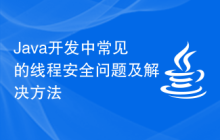
在Java开发中,多线程是一个非常常见且重要的概念。然而,多线程也往往会带来一系列的线程安全问题。线程安全问题指的是多个线程同时访问共享资源时可能会出现的数据错误、逻辑错误等问题。本文将介绍一些常见的线程安全问题,并提供相应的解决方法,同时附上代码示例。
- 竞态条件(Race Condition)
竞态条件是指多个线程同时访问并修改共享资源,导致资源的最终结果与期望不符的问题。常见的竞态条件问题包括计数器递增、数据读写等。
解决方法一:使用synchronized关键字
通过在关键代码段上使用synchronized关键字,可以保证同一时间只有一个线程可以执行该代码段,从而避免竞态条件问题。
代码示例:
class Counter {
private int count = 0;
public synchronized void increment() {
count++;
}
public int getCount() {
return count;
}
}解决方法二:使用Lock接口
使用Lock接口可以提供更细粒度的锁定,与synchronized相比,Lock接口更加灵活。
代码示例:
import java.util.concurrent.locks.Lock;
import java.util.concurrent.locks.ReentrantLock;
class Counter {
private int count = 0;
private Lock lock = new ReentrantLock();
public void increment() {
lock.lock();
try {
count++;
} finally {
lock.unlock();
}
}
public int getCount() {
return count;
}
}- 死锁(Deadlock)
死锁是指多个线程相互等待对方释放资源,导致程序无法继续执行的问题。
预防死锁的方法主要有两种:
一是避免循环依赖;
二是使用线程池(ThreadPoolExecutor)代替单独创建线程,线程池可以有效管理线程的生命周期,防止死锁。
代码示例:
import java.util.concurrent.ExecutorService;
import java.util.concurrent.Executors;
class Resource {
private final Object lock1 = new Object();
private final Object lock2 = new Object();
public void methodA() {
synchronized (lock1) {
synchronized (lock2) {
// do something
}
}
}
public void methodB() {
synchronized (lock2) {
synchronized (lock1) {
// do something
}
}
}
}
public class Main {
public static void main(String[] args) {
ExecutorService executorService = Executors.newFixedThreadPool(2);
Resource resource = new Resource();
executorService.submit(() -> resource.methodA());
executorService.submit(() -> resource.methodB());
executorService.shutdown();
}
}- 线程间通信问题
线程间通信问题主要指的是一个线程等待另一个线程的操作结果,常见的场景包括生产者-消费者问题、线程池任务返回值等。
解决方法:使用wait()和notify()方法配合使用
wait()方法可以使当前线程等待,而notify()方法可以唤醒一个等待的线程。
代码示例:
class SharedResource {
private int value;
private boolean isValueSet = false;
public synchronized void setValue(int value) {
while (isValueSet) {
try {
wait();
} catch (InterruptedException e) {
e.printStackTrace();
}
}
this.value = value;
isValueSet = true;
notify();
}
public synchronized int getValue() {
while (!isValueSet) {
try {
wait();
} catch (InterruptedException e) {
e.printStackTrace();
}
}
isValueSet = false;
notify();
return value;
}
}
public class Main {
public static void main(String[] args) {
SharedResource sharedResource = new SharedResource();
Thread producer = new Thread(() -> {
for (int i = 0; i < 10; i++) {
sharedResource.setValue(i);
System.out.println("Producer produces: " + i);
try {
Thread.sleep(1000);
} catch (InterruptedException e) {
e.printStackTrace();
}
}
});
Thread consumer = new Thread(() -> {
for (int i = 0; i < 10; i++) {
int value = sharedResource.getValue();
System.out.println("Consumer consumes: " + value);
try {
Thread.sleep(1000);
} catch (InterruptedException e) {
e.printStackTrace();
}
}
});
producer.start();
consumer.start();
}
}在Java开发中,线程安全问题是一个需要特别关注的问题。通过了解常见的线程安全问题以及相应的解决方法,我们可以更好地编写线程安全的代码,提高程序的质量和可靠性。
1. 本站所有资源来源于用户上传和网络,如有侵权请邮件联系站长!
2. 分享目的仅供大家学习和交流,您必须在下载后24小时内删除!
3. 不得使用于非法商业用途,不得违反国家法律。否则后果自负!
4. 本站提供的源码、模板、插件等等其他资源,都不包含技术服务请大家谅解!
5. 如有链接无法下载、失效或广告,请联系管理员处理!
6. 本站资源售价只是赞助,收取费用仅维持本站的日常运营所需!
源码库 » Java开发中常见的线程安全问题及解决方法
2. 分享目的仅供大家学习和交流,您必须在下载后24小时内删除!
3. 不得使用于非法商业用途,不得违反国家法律。否则后果自负!
4. 本站提供的源码、模板、插件等等其他资源,都不包含技术服务请大家谅解!
5. 如有链接无法下载、失效或广告,请联系管理员处理!
6. 本站资源售价只是赞助,收取费用仅维持本站的日常运营所需!
源码库 » Java开发中常见的线程安全问题及解决方法










![[7W+资源站]整站数据打包-大小30G数据资源](https://we7-cn.oss-cn-beijing.aliyuncs.com/wp-content/uploads/2021/06/1623897449-1bc98e623a6c51f.png?x-oss-process=image/resize,m_fill,h_200,w_300)